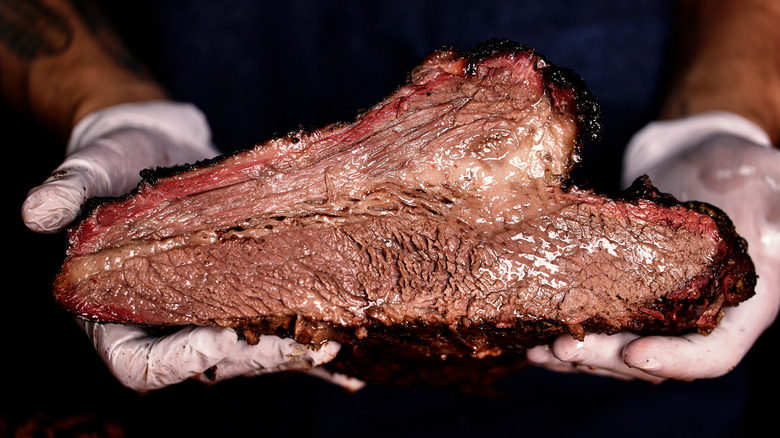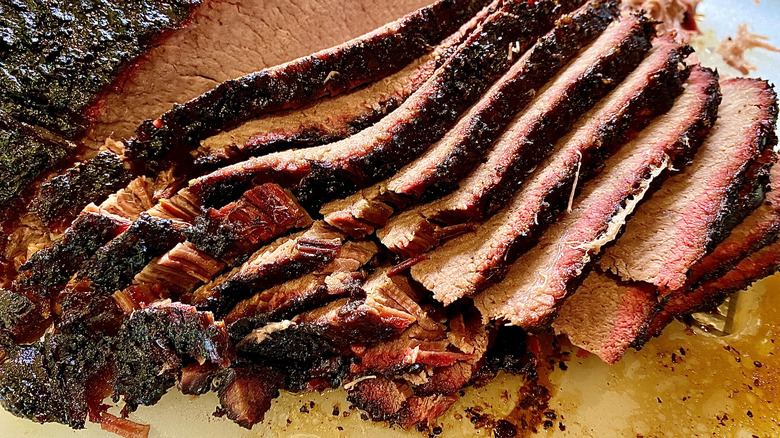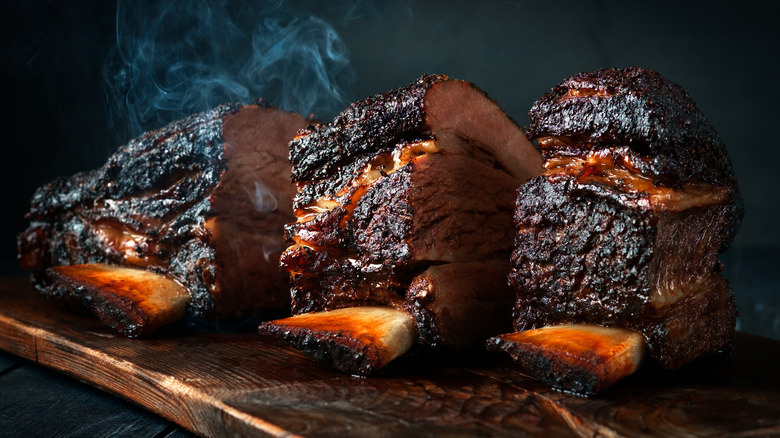Here's What Makes Texas Brisket Stand Out From The Rest
There are all sorts of regional barbecue styles in America, from Memphis to Kansas City to Alabama. Heck, there are four distinct styles that make up the difference between North and South Carolina barbecue alone. But when it comes to smoked meats, maybe nowhere values barbecue more highly than Texas — and no meat is more highly valued in the Lone Star State than brisket. In general, brisket is considered the ultimate challenge when it comes to smoking meat, and it's a challenge that Texas pitmasters take very, very seriously.
Texas brisket has a bunch of unique steps in its cooking process when compared to other barbecue varieties. It typically uses a less complex spice rub, utilizes a specific type of wood, cooks the entire cut of brisket (both the flat and the point), and gets cooked for a very, very long time. All of these factors combine to form the distinctive crispy bark that makes Texas brisket stand head and shoulders above other regional smoked briskets (at least, according to Texans).
Texas brisket takes its time and doesn't waste meat
The smoking process is the key with Texas brisket. After all, brisket is the meat you need to avoid grilling at all costs, as high heat for short periods will just cause it to tighten up and become tough. The way brisket is typically cooked in Texas, though, goes as far as possible in the other direction from this problem. To say that Texas brisket takes a while to cook compared to other barbecue is a bit like describing the Pacific Ocean as "mildly damp;" technically accurate, but somewhat incomplete.
Texas brisket can be cooked for upwards of 20 hours on low temperatures, meaning this is a meal you have to prepare for well in advance. There are variations depending on what part of Texas you're in, too. Central Texas brisket is the classic minimalist preparation that's served with sauce on the side, while the East Texas version is cooked the longest and served with a tomato-based sauce. South Texas brisket, meanwhile, adds marinades before the smoking process. The principle is the same across all these varieties, though: You take your time when you're smoking brisket.
Texas brisket also makes use of the whole cut. While a lot of briskets will simply rely on the brisket flat because it's easier to cook more quickly (ultimately using the point for producing the flavorful treat known as burnt ends), Texas brisket doesn't distinguish. The low and slow method that Texan pitmasters employ allows the additional connective tissue in the point to break down, leading to a more flavorful overall cook.
Texas brisket is prized for its beautiful bark
But low and slow heat isn't the only way you get to Texas brisket. While many brisket varieties might involve complex spice rubs, Texas styles frequently go in the other direction, using only salt and pepper and allowing the meat's flavor to be the star. And while you can theoretically smoke with a lot of types of wood, Texas brisket makes use of one specific variety: post oak. Make no mistake, picking the right type of wood for smoking meat matters, and in the case of post oak, it has a distinctive somewhat spicy and smoky flavor that has become synonymous with Texas barbecue.
The end result of all of these particular choices is the formation of the single quality that most sets Texas brisket apart: the bark. Cooking with post oak for long periods at low heat with a simple spice rub ultimately results in a crispy crust with a ton of flavor that serves as a deliberate textural counterpoint to the tenderness of the meat. For many pitmasters as well as barbecue lovers, the bark is the key to a great brisket — and the Texas method is designed to produce the most ideal version of it. Given how much care goes into the process to create this perfect bark, it's no surprise that Texas brisket is generally considered the best you can find.


